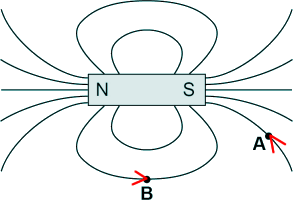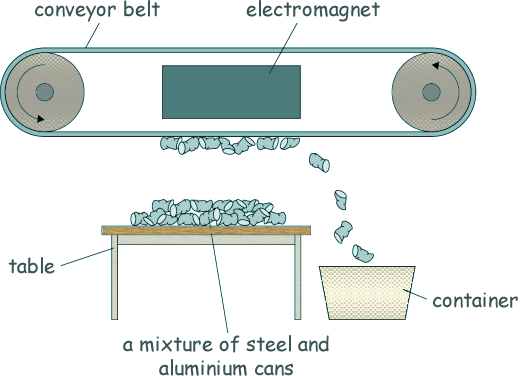GCSE Level Questions: Magnets and Electromagnets
Q9.
(a) The diagram below shows the magnetic field pattern around a bar magnet.

Draw an arrow at point A and point B to show the direction of the magnetic field at each point.
[1 mark]
(b) A magnets can be one of several types: an electromagnet, an induced magnet or a permanent magnet.
A bar magnet produces its own magnetic field.
What type of magnet is a bar magnet?
A permanent magnet 
[1 mark]
(c) Which of the following sketch graphs shows how the strength of the magnetic field varies with distance from the bar magnet?

Give a reason for your answer.
C  - the magnetic field gets weaker as you move away from the magnet and C is the only one that shows that.
- the magnetic field gets weaker as you move away from the magnet and C is the only one that shows that. 
[2 marks]
(d) The diagram shows an electromagnet being used to separate aluminium cans from steel cans.

(i) Explain how the electromagnet and conveyor belt are used to separate the steel cans from the aluminium cans.
Steel cans are attracted to the electromagnet and are transferred to the container by the conveyor belt.  Aluminium cans are not attracted to the electromagnet, so they do not get transferred to the conveyor but remain on the table.
Aluminium cans are not attracted to the electromagnet, so they do not get transferred to the conveyor but remain on the table. 
[2 marks]
(ii) At the top of the table the strength of the magnetic field is only just enough to pick the cans up. Describe two ways to increase the strength of magnetic field at the top of the table.
Decrease the distance between the cans and the electromagnet 
You could make the distance between the table top and the electromagnet shorter. So you could raise the height of the table or use a taller table or put this one on a platform or put a (non-magnetic) box on top of the table. You could also lower the electromagnet
Increase the strength of the electromagnet used. 
You could use a larger potential difference to increase the current flowing through the coils or use a stronger electromagnet - one with more coils
[2 marks]
(iii) The conveyor belt moves a can at a speed of 1.7 m/s.
Calculate the time taken to move the can 3.3 m at this speed.
Give your answer to 2 significant figures.
speed = distance travelled/time taken
v = s/t 
1.7 = 3.3/t
t = 3.3/1.7 
t = 1.94 s 
To 2 sf that is 1.9 s 
[4 marks]
(TOTAL 12 marks)









